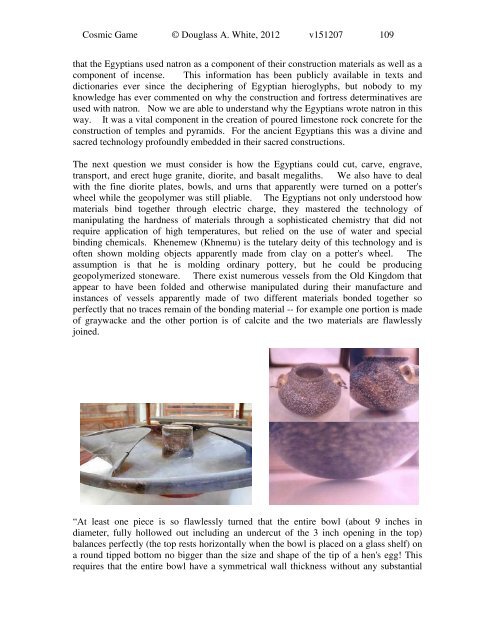Create successful ePaper yourself
Turn your PDF publications into a flip-book with our unique Google optimized e-Paper software.
<strong>Cosmic</strong> <strong>Game</strong> © Douglass A. White, 2012 v151207 109<br />
that the Egyptians used natron as a <strong>com</strong>ponent of their construction materials as well as a<br />
<strong>com</strong>ponent of incense. This information has been publicly available in texts and<br />
dictionaries ever since the deciphering of Egyptian hieroglyphs, but nobody to my<br />
knowledge has ever <strong>com</strong>mented on why the construction and fortress determinatives are<br />
used with natron. Now we are able to understand why the Egyptians wrote natron in this<br />
way. It was a vital <strong>com</strong>ponent in the creation of poured limestone rock concrete for the<br />
construction of temples and pyramids. For the ancient Egyptians this was a divine and<br />
sacred technology profoundly embedded in their sacred constructions.<br />
<strong>The</strong> next question we must consider is how the Egyptians could cut, carve, engrave,<br />
transport, and erect huge granite, diorite, and basalt megaliths. We also have to deal<br />
with the fine diorite plates, bowls, and urns that apparently were turned on a potter's<br />
wheel while the geopolymer was still pliable. <strong>The</strong> Egyptians not only understood how<br />
materials bind together through electric charge, they mastered the technology of<br />
manipulating the hardness of materials through a sophisticated chemistry that did not<br />
require application of high temperatures, but relied on the use of water and special<br />
binding chemicals. Khenemew (Khnemu) is the tutelary deity of this technology and is<br />
often shown molding objects apparently made from clay on a potter's wheel. <strong>The</strong><br />
assumption is that he is molding ordinary pottery, but he could be producing<br />
geopolymerized stoneware. <strong>The</strong>re exist numerous vessels from the Old Kingdom that<br />
appear to have been folded and otherwise manipulated during their manufacture and<br />
instances of vessels apparently made of two different materials bonded together so<br />
perfectly that no traces remain of the bonding material -- for example one portion is made<br />
of graywacke and the other portion is of calcite and the two materials are flawlessly<br />
joined.<br />
“At least one piece is so flawlessly turned that the entire bowl (about 9 inches in<br />
diameter, fully hollowed out including an undercut of the 3 inch opening in the top)<br />
balances perfectly (the top rests horizontally when the bowl is placed on a glass shelf) on<br />
a round tipped bottom no bigger than the size and shape of the tip of a hen's egg! This<br />
requires that the entire bowl have a symmetrical wall thickness without any substantial





